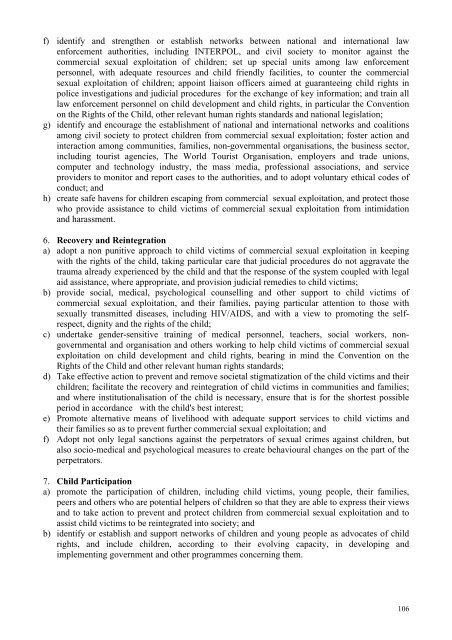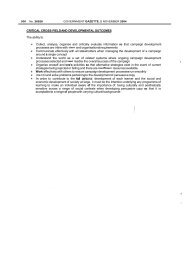The trafficking of children for purposes of sexual exploitation
The trafficking of children for purposes of sexual exploitation
The trafficking of children for purposes of sexual exploitation
You also want an ePaper? Increase the reach of your titles
YUMPU automatically turns print PDFs into web optimized ePapers that Google loves.
f) identify and strengthen or establish networks between national and international law<br />
en<strong>for</strong>cement authorities, including INTERPOL, and civil society to monitor against the<br />
commercial <strong>sexual</strong> <strong>exploitation</strong> <strong>of</strong> <strong>children</strong>; set up special units among law en<strong>for</strong>cement<br />
personnel, with adequate resources and child friendly facilities, to counter the commercial<br />
<strong>sexual</strong> <strong>exploitation</strong> <strong>of</strong> <strong>children</strong>; appoint liaison <strong>of</strong>ficers aimed at guaranteeing child rights in<br />
police investigations and judicial procedures <strong>for</strong> the exchange <strong>of</strong> key in<strong>for</strong>mation; and train all<br />
law en<strong>for</strong>cement personnel on child development and child rights, in particular the Convention<br />
on the Rights <strong>of</strong> the Child, other relevant human rights standards and national legislation;<br />
g) identify and encourage the establishment <strong>of</strong> national and international networks and coalitions<br />
among civil society to protect <strong>children</strong> from commercial <strong>sexual</strong> <strong>exploitation</strong>; foster action and<br />
interaction among communities, families, non-governmental organisations, the business sector,<br />
including tourist agencies, <strong>The</strong> World Tourist Organisation, employers and trade unions,<br />
computer and technology industry, the mass media, pr<strong>of</strong>essional associations, and service<br />
providers to monitor and report cases to the authorities, and to adopt voluntary ethical codes <strong>of</strong><br />
conduct; and<br />
h) create safe havens <strong>for</strong> <strong>children</strong> escaping from commercial <strong>sexual</strong> <strong>exploitation</strong>, and protect those<br />
who provide assistance to child victims <strong>of</strong> commercial <strong>sexual</strong> <strong>exploitation</strong> from intimidation<br />
and harassment.<br />
6. Recovery and Reintegration<br />
a) adopt a non punitive approach to child victims <strong>of</strong> commercial <strong>sexual</strong> <strong>exploitation</strong> in keeping<br />
with the rights <strong>of</strong> the child, taking particular care that judicial procedures do not aggravate the<br />
trauma already experienced by the child and that the response <strong>of</strong> the system coupled with legal<br />
aid assistance, where appropriate, and provision judicial remedies to child victims;<br />
b) provide social, medical, psychological counselling and other support to child victims <strong>of</strong><br />
commercial <strong>sexual</strong> <strong>exploitation</strong>, and their families, paying particular attention to those with<br />
<strong>sexual</strong>ly transmitted diseases, including HIV/AIDS, and with a view to promoting the selfrespect,<br />
dignity and the rights <strong>of</strong> the child;<br />
c) undertake gender-sensitive training <strong>of</strong> medical personnel, teachers, social workers, nongovernmental<br />
and organisation and others working to help child victims <strong>of</strong> commercial <strong>sexual</strong><br />
<strong>exploitation</strong> on child development and child rights, bearing in mind the Convention on the<br />
Rights <strong>of</strong> the Child and other relevant human rights standards;<br />
d) Take effective action to prevent and remove societal stigmatization <strong>of</strong> the child victims and their<br />
<strong>children</strong>; facilitate the recovery and reintegration <strong>of</strong> child victims in communities and families;<br />
and where institutionalisation <strong>of</strong> the child is necessary, ensure that is <strong>for</strong> the shortest possible<br />
period in accordance with the child's best interest;<br />
e) Promote alternative means <strong>of</strong> livelihood with adequate support services to child victims and<br />
their families so as to prevent further commercial <strong>sexual</strong> <strong>exploitation</strong>; and<br />
f) Adopt not only legal sanctions against the perpetrators <strong>of</strong> <strong>sexual</strong> crimes against <strong>children</strong>, but<br />
also socio-medical and psychological measures to create behavioural changes on the part <strong>of</strong> the<br />
perpetrators.<br />
7. Child Participation<br />
a) promote the participation <strong>of</strong> <strong>children</strong>, including child victims, young people, their families,<br />
peers and others who are potential helpers <strong>of</strong> <strong>children</strong> so that they are able to express their views<br />
and to take action to prevent and protect <strong>children</strong> from commercial <strong>sexual</strong> <strong>exploitation</strong> and to<br />
assist child victims to be reintegrated into society; and<br />
b) identify or establish and support networks <strong>of</strong> <strong>children</strong> and young people as advocates <strong>of</strong> child<br />
rights, and include <strong>children</strong>, according to their evolving capacity, in developing and<br />
implementing government and other programmes concerning them.<br />
106
















